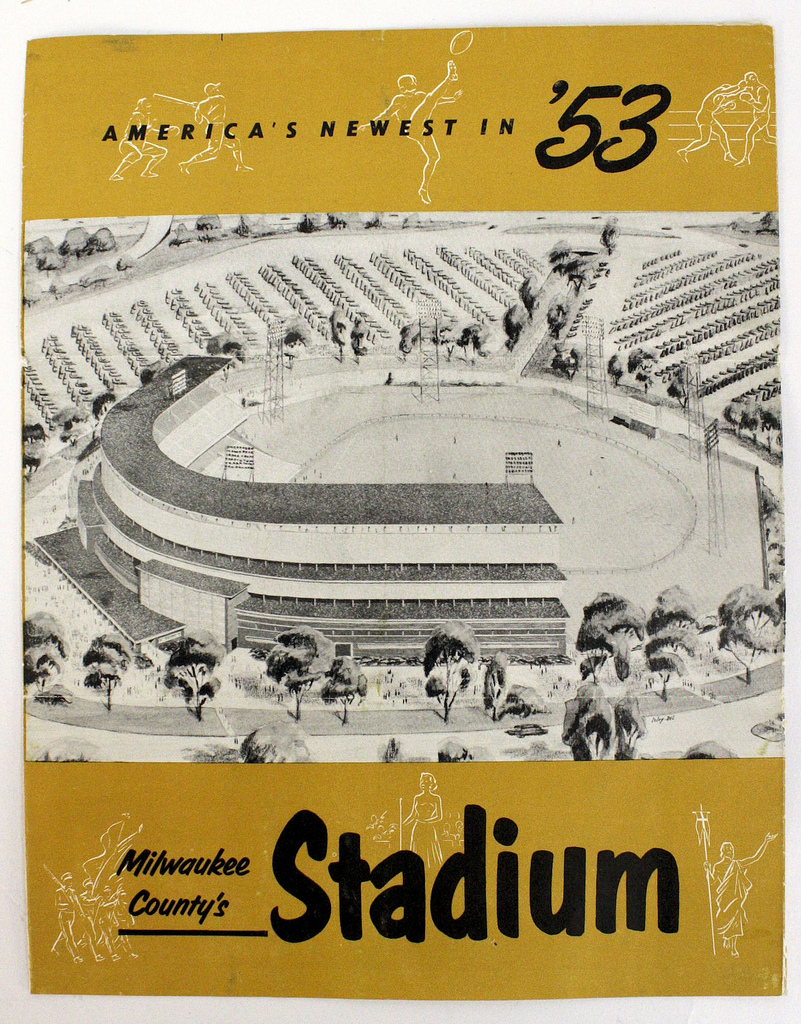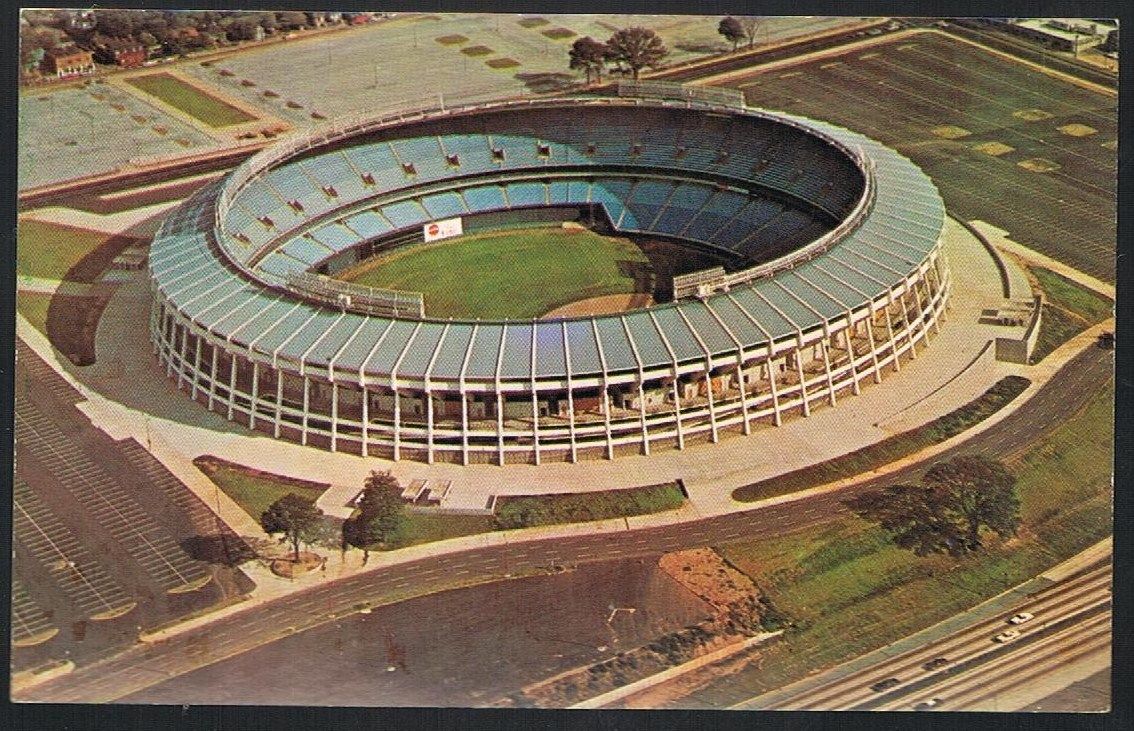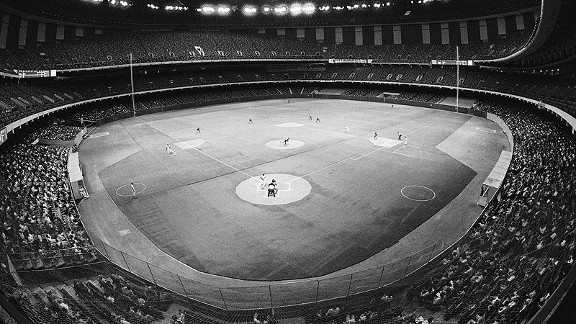The dream is the same for every Minor League baseball player: Learn the craft, hone the skills and make the jump to the Major Leagues, leaving behind the smaller, antiquated, hometown feel of the Minor League ballpark for the modern, awe-inspiring cathedrals of The Show. But on the rarest of occasions in baseball history, it’s been the ballpark itself that has gotten the call.
Parks originally built for Minor League life have, by accident or design, found themselves becoming hosts in the Major Leagues, in some cases becoming legendary homes for Major League Baseball’s greatest teams and moments.
Today, the idea that a Minor League park, no matter how cleverly designed, could be coveted and taken over by a Major League franchise, is a fantasy that would rival “Field of Dreams.” But if there is a dream out there, here are some historic examples that proved if you build it, they will come.
MEMORIAL STADIUM — BALTIMORE
Much to the chagrin of baseball writers and newspaper editors who prefer using the shorthand version, the Baltimore Orioles do not play their 81 home games at Camden Yards. They play them at Oriole Park at Camden Yards.
The full name is an homage to Baltimore’s baseball past, and a Minor League ballpark that died in order that Major League baseball could live and thrive in Charm City.
Back in 1944, there were two stadiums in Baltimore. One was Municipal Stadium, a 65,000-seat football stadium later to become the iconic home of Johnny Unitas and the Colts. The other stadium was Oriole Park, where the Orioles of the International League played and enjoyed tremendous success, winning titles in 1936, ’37 and ’40.
But in July 1944, a fire destroyed Oriole Park, forcing the Orioles to take temporary refuge at Municipal Stadium. It was an abrupt change for a team in a pennant race, but whatever hardship the Orioles’ front office endured by losing their home was quickly soothed by the attendance phenomenon that the venue change created.
Oriole Park’s seating capacity was just 11,000. But in their first game at Municipal after the fire, a crowd of 13,000 turned out. As the season lurched toward a frantic finish, with the Orioles capturing another International League title, crowds attending games at Municipal were said to range between 20,000 and 40,000. For Game 4 of the Junior World Series, a crowd of 52,833 watched the Orioles take on Louisville — almost 17,000 more than for the highest-attended Major League World Series game that year.
Major League Baseball took notice. And when the city of Baltimore began upgrading the facility in 1950 and re-named it Memorial Stadium, not only did it become an NFL mainstay as the Colts joined the league, but when it was completed in 1954, it welcomed the St. Louis Browns at the new American League Baltimore Orioles, hosting three World Series champions before giving way to Camden Yards in 1992.
Photo courtesy Maryland Historical Society.
TURNPIKE STADIUM — ARLINGTON, TX
Everything is bigger in Texas, and that included baseball dreams and designs in the 1960s. As Major League Baseball underwent major western and southern expansion in the late 1950s and early ’60s, Texas became a major player to land teams. In Houston, they built the famous Astrodome and welcomed the Astros (née the Colt .45s) to the National League.
The process was a bit more evolutionary in the American League. The Dallas Metroplex had a Minor League team, the Dallas-Fort Worth Spurs, and its stadium in Arlington, called Turnpike Stadium, was built to hold 10,000 fans. But the plan for Turnpike was never Minor League. Although it originally held 10,000, it was designed to be upgraded to a 50,000-seat stadium, just waiting for the day Major League Baseball came calling to Dallas.
The Spurs played seven seasons at Turnpike Stadium, but during its fourth year in 1968, the majority stake in the Washington Senators was purchased by Robert Short, who determined to move the team to Arlington. Between then and 1972, Turnpike Stadium underwent the always-anticipated expansion, increasing its capacity to 35,500 and being re-named Arlington Stadium, where the new Texas Rangers debuted in 1972. The capacity was enlarged again in the late 1970s to 42,000 and the team played at Arlington Stadium until 1994, when The Ballpark at Arlington (now Globe Life Park) replaced it.
COUNTY STADIUM — MILWAUKEE
In terms of Western expansion in baseball, the most famous examples are the Dodgers and Giants leaving the boroughs of New York in the late 1950s for Los Angeles and San Francisco. But those moves might never have been possible if not for what took place in Milwaukee in 1953.
In that sense, Milwaukee’s County Stadium might be the most influential ballpark in Major League history. It also makes this list as a stadium built for the Minors that later came to host a Major League team. But in that sense, County Stadium comes with Maris-like asterisk: No Minor League team actually played at County Stadium.
The original plan to bring Major League baseball to Milwaukee had been decades in the making, but it wasn’t until 1948 that the city began the process of building a ballpark that could be considered Major League material.
Intended to be the home of the Milwaukee Brewers, the Triple-A affiliate of the Boston Braves, construction of County Stadium began in 1950, but the project was nearly scrapped because of the impact of the Korean War, which drew the United States into the fight that same year.
The stadium project, which was the first in U.S. history to rely on public funds — $5 million in Milwaukee city and county bonds — required approval from U.S. Congress to allow materials, notably steel, to be diverted from the war effort for the purpose of building a ballpark. Had groundbreaking on the project not occurred a week before a national ban on recreational facility construction, the project would have been scuttled. But Congress not only allowed the construction to take place, it leased 22 acres of federally owned land for the project.
By the start of the 1953 season, Milwaukee County Stadium, with a capacity of over 34,000, was ready to host the Brewers. But the call for the Brewers never came. Instead, the owners of the Braves, hemorrhaging money in Boston, decided the Milwaukee site was so enticing, they petitioned Major League Baseball to move the Braves. The move was approved, and it was the Milwaukee Braves who began play in 1953 and enjoyed a remarkable reversal of on- and off-field fortune, winning 92 games in its first Milwaukee season and setting the single-season National League attendance record — a feat no doubt noticed in the front offices of the Dodgers and Giants. County Stadium would eventually be replaced by Miller Park.
METROPOLITAN STADIUM — MINNESOTA
The Braves’ move to Milwaukee in 1953 was absolutely noticed by Minneapolis Chamber of Commerce President Gerald Moore, who saw the popularity of the Braves and realized his city was equally ripe for Major League success.
 At the time, the Minneapolis Millers of the American Association played at 4,000-seat Nicollet Park. Under Moore’s leadership, a 160-arce plot of land in Bloomington — between the Twin Cities of Minneapolis and St. Paul — was approved for the construction of a much larger baseball facility to house the Millers in the short term and lure a Major League franchise in the big picture.
At the time, the Minneapolis Millers of the American Association played at 4,000-seat Nicollet Park. Under Moore’s leadership, a 160-arce plot of land in Bloomington — between the Twin Cities of Minneapolis and St. Paul — was approved for the construction of a much larger baseball facility to house the Millers in the short term and lure a Major League franchise in the big picture.
Groundbreaking took place in 1955, and the new Metropolitan Stadium opened in 1956, with the Millers playing there for five seasons. (It was an odd-looking ballpark, consisting mainly of the three-deck cantilevered grandstand, as shown to the right. It would be expanded with new seating down each line when the Twins came to town.) But during those five years, several teams negotiated for the rights to move to Minneapolis, including the New York Giants, the parent club of the Millers. (Indeed, Giants owner Horace Stoneham once bought land in a Minneapolis suburb for a new ballpark.) The Giants eventually moved to San Francisco, and the Millers became the affiliate of the Red Sox.
The Cincinnati Reds, Cleveland Indians, Philadelphia A’s and Washington Senators also considered moving to Bloomington, but ultimately it was Calvin Griffith’s Senators that made the move to Metropolitan Stadium in 1961. Ironically, it was against the replacement Washington Senators that the Major League Minnesota Twins debuted at the Met. Those second set of Senators would later move to Arlington to play at the renovated Arlington (Turnpike) Stadium. Eventually the Met would be torn down after the Twins moved to the downtown Metrodome, replaced by the Mall of America.
ATLANTA-FULTON COUNTY STADIUM — ATLANTA
The Braves make a second appearance in this story, as Atlanta-Fulton County Stadium was the next stop for the team after Milwaukee County Stadium. By 1961 Atlanta business leaders were pushing the Georgia capital as the new heart of the South, and the thinking at the time was that any major U.S. city required major-league sports. Mayor Ivan Allen Jr. and influential Atlanta Journal sports editor Furman Bisher went to work on persuading an MLB team to make the move. Kansas City A’s owner Charlie O. Finley, in the midst of burning bridges, was set to make the move but was denied by MLB owners. Next up: the Braves, whose new owner Bill Bartholomay was openly seeking a larger market and agreed to the move. So Atlanta and Fulton County went ahead with a new ballpark, set to open in 1965.
One snag: the Braves were barred from moving after a lawsuit, so Atlanta Stadium (as it was originally known) hosted the International Legue’s Atlanta Crackers for a season. Technically, this isn’t a case of a MiLB ballpark being expanded for MLB — but it is a case of an MiLB playing at a ballpark before the MLB team arrived. Atlanta-Fulton County Stadium was torn down after the 1996 Summer Olympics, replaced by Turner Field as home of the Braves, but the playing field is still marked out in the parking lot.
SUPERDOME — NEW ORLEANS
One city with Major League dreams had the field, but they never came. The Louisiana Superdome in New Orleans is synonymous with the NFL and the Super Bowl, but in 1977, the domed stadium was also home to a Minor League baseball team. Long before Anthony Davis brought his unibrow to the Crescent City, the New Orleans Pelicans played baseball in the Superdome.
Owner A. Ray Smith relocated the Triple-A Tulsa Oilers to New Orleans for the 1977 season, and future Hall of Fame manager Tony La Russa was the starting shortstop.
Over the course of their one season, the Pelicans drew a total attendance of 217,957, but Smith had the St. Louis Cardinals’ farm team back on the move in 1978, this time to Springfield, Ill.
With an attendance capacity of 63,525, the indoor Superdome seemed a logical relocation or expansion destination for Major League Baseball. And two teams, the Oakland A’s in 1979 and the Pittsburgh Pirates in 1981, gave consideration to making the move, but neither deal reached fruition.
The Superdome did draw its share of Major League games, hosting exhibition games throughout the 1980s and ’90s, but no professional baseball has been played in the 40-year-old Superdome since 1999.







